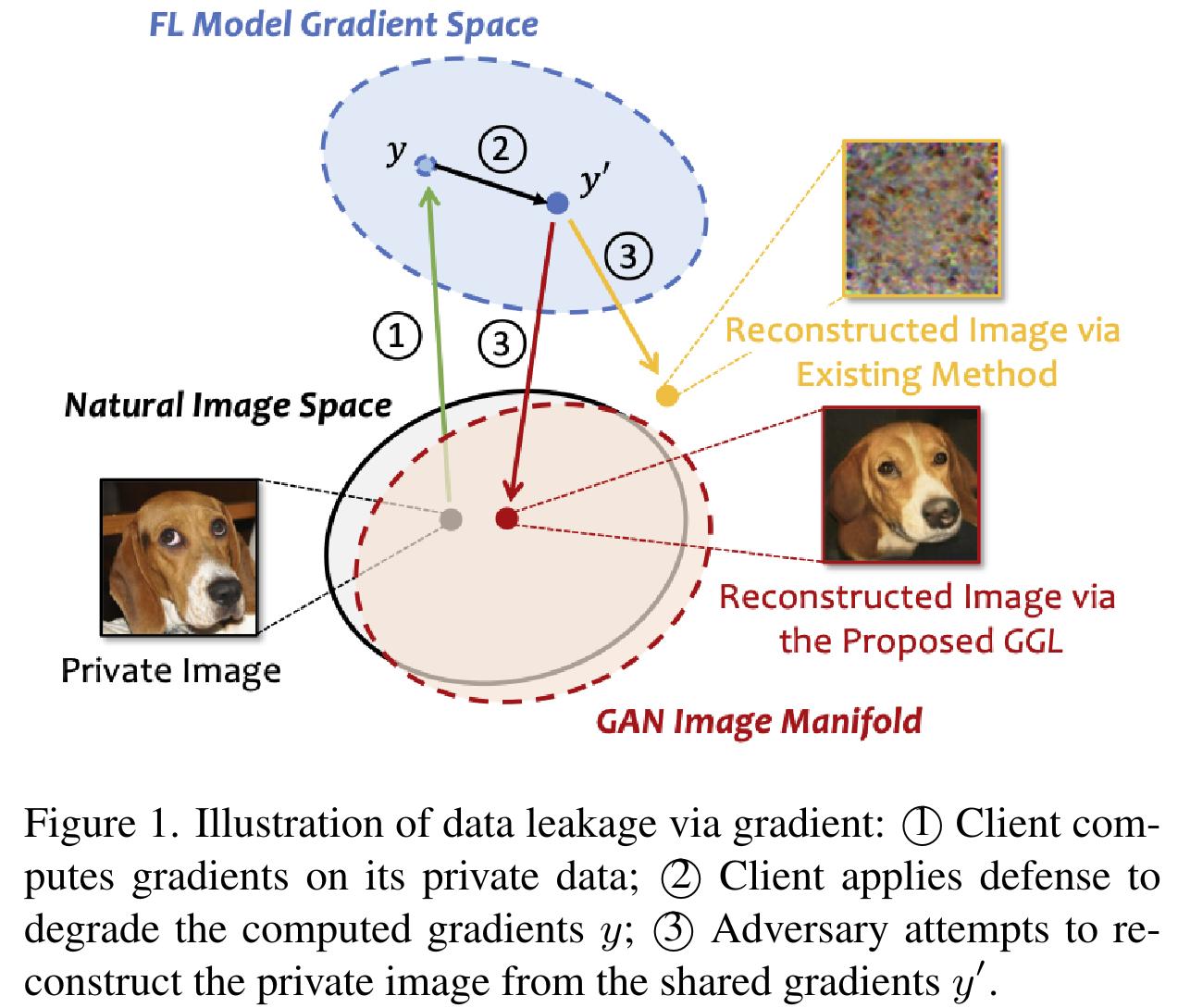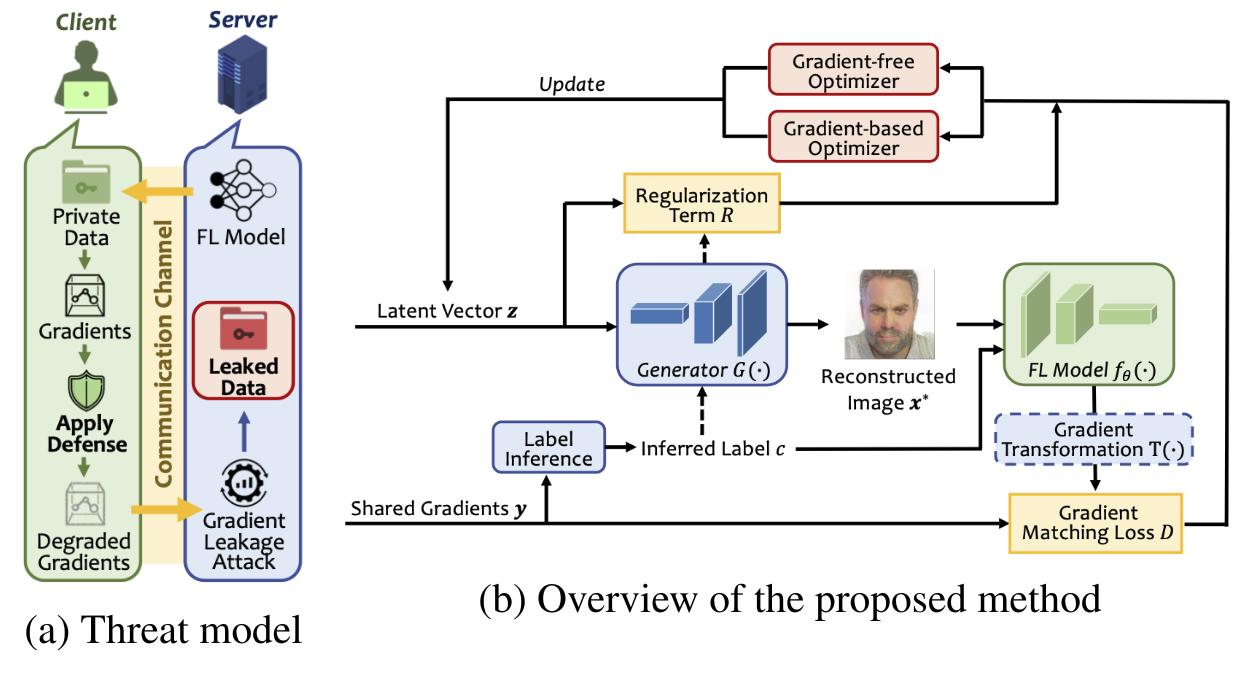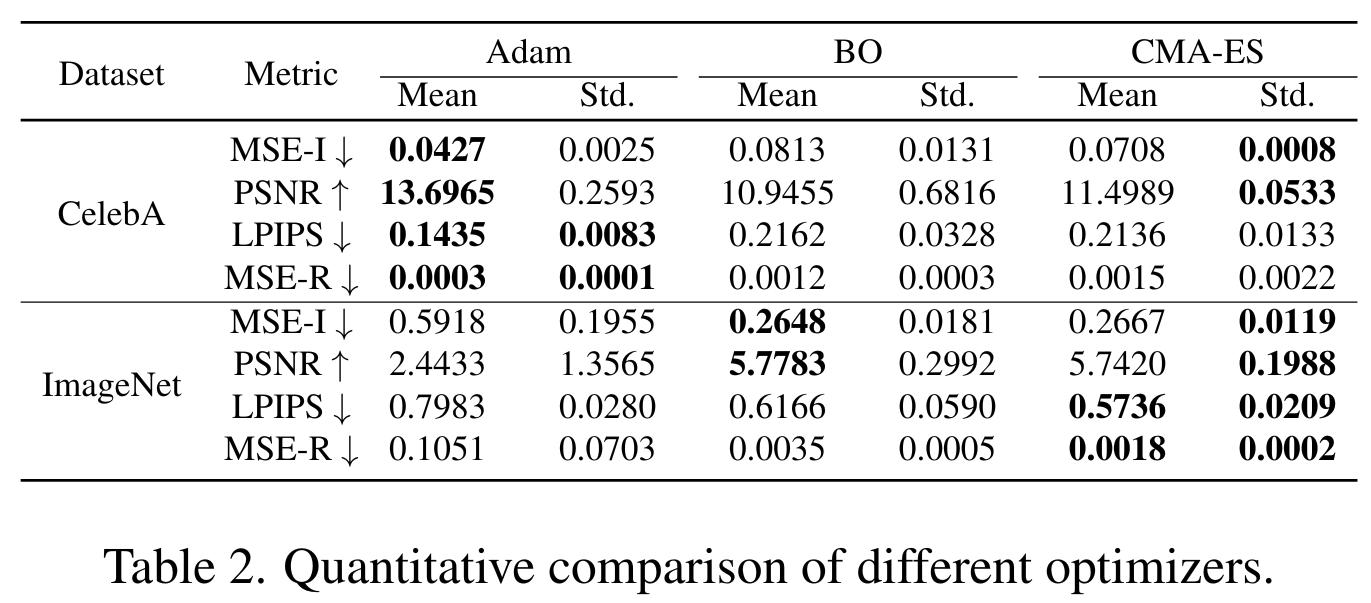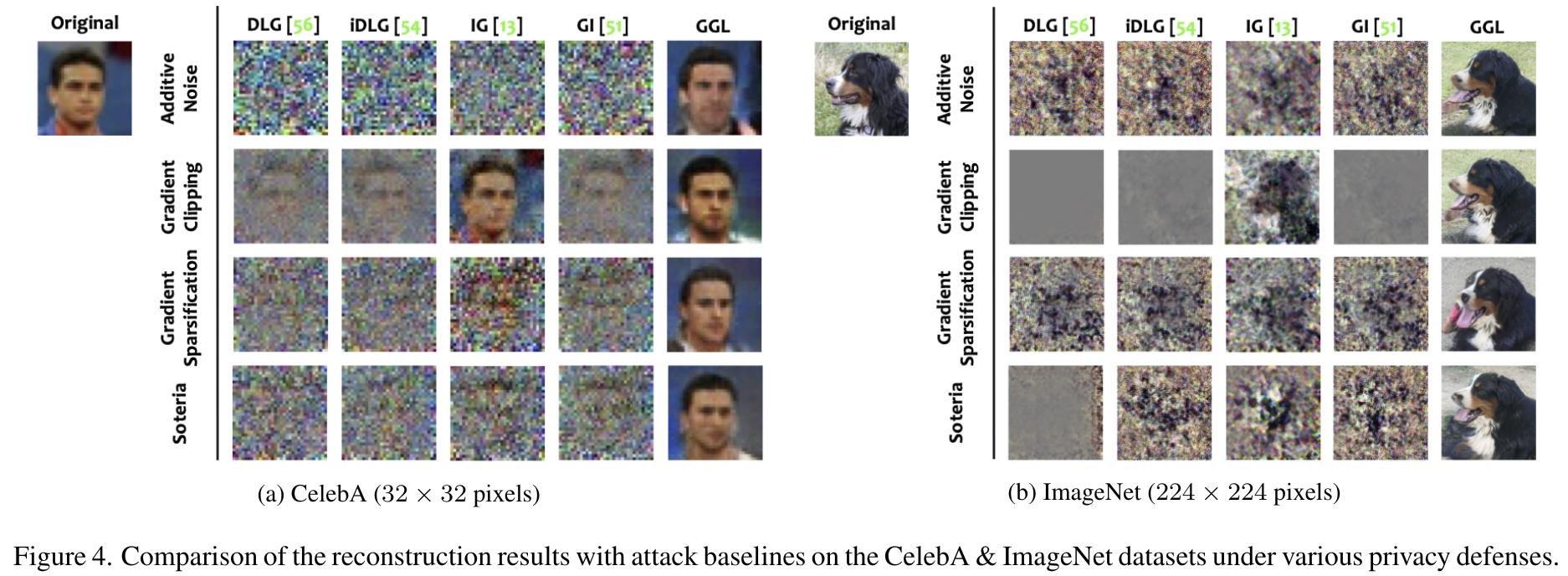Auditing Privacy Defenses in Federated Learning via Generative Gradient Leakage
Notes
- Code is available on github
Introduction
- Federated learning was initially presented as a fully privacy-preserving decentralized learning paradigm, never sharing raw data between participants and the server.

-
Soon after its proposal, attacks designed to extract information from the transmitted local updates were developed, the most notable being Deep Leakage from Gradients1, but working efficiently on small-sized inputs only.
-
The authors propose a new type of attack, Generative Gradient Leakage, leveraging external data server-side to train a generative model used to regularize a gradient inversion attack.

- They show promising results attacking federated frameworks training on ImageNet and CelebA, reconstructing a large image from a gradient.
Overview

Threat model
- Honest-but-curious server. It behaves normally, but will try its best to infer private information from what is accessible to it, models and degraded local updates.
- Participants apply a variety of local defense mechanisms,
- Access to external data server-side from the same distribution as participants.
Problem definition
Notations
- \(x\in\mathbb{R}^{h\times w}\) an image with associated class label \(c\),
- \(F(x)=\nabla_{\theta}\mathcal{L}(f_{\theta}(x),c)\) the gradient of \(x\) with respect to parameters \(\theta\in\mathbb{R}^p\) of a network \(f_{\theta}\),
- \(y=\mathcal{T}(F(x))\) a gradient degraded by the defence transformation \(\mathcal{T}\),
- \(w: \mathbb{R}^{h\times w}\rightarrow \mathbb{R}\) an image prior defining the likelihood of an image,
- \(\mathcal{D}: \mathbb{R}^p\times\mathbb{R}^p\rightarrow \mathbb{R}\) a distance metric between gradients,
- \(G: \mathbb{R}^k\rightarrow \mathbb{R}^{h\times w}\) a generative network trained on external data server-side,
- \(\mathcal{R}(G;z)\) a regularization term, penalizing latent vector \(z\) when deviating from the prior distribution.
Previous formulation1
\[x^* = \underset{x\in\mathbb{R}^{h\times d}}{argmin\ } \underbrace{\mathcal{D}(y, F(x))}_\text{gradient matching loss} + \underbrace{\lambda \omega(x)}_\text{regularization}\]Novel formulation
\[z^* = \underset{z\in\mathbb{R}^{k}}{argmin\ } \underbrace{\mathcal{D}(y, \mathcal{T}(F(G(z))))}_\text{gradient matching loss} + \underbrace{\lambda \mathcal{R}(G; z)}_\text{regularization}\]Method
Analytical label inference
For networks with a fully connected classification head using sigmoid or ReLu activation functions trained with cross-entropy loss on one-hot labels, the label can be inferred through the index of the negative entry of the gradient with respect to this layer.
Gradient Transformation Estimations
Gradient Clipping: Given a perturbation \(\mathcal{T}(w, S) = w/\text{max}(1,\frac{||w||_2}{S})\), estimate the clipping bound \(S\) as the \(l_2\) norm at each layer,
Gradient Sparsification: Given a perturbation \(\mathcal{T}(w,p) = y \odot \mathcal{M}\) with \(\mathcal{M}\) a mask with pruning rate \(p\), simply estimate \(\mathcal{M}\) using the zero entries of the gradient.
Gradient Matching Losses
Squared \(l_2\) norm
\[\mathcal{D}(y, \tilde{y}) = ||y - \tilde{y}||^2_2\]Cosine similarity
\[\mathcal{D}(y, \tilde{y}) = 1 - \frac{<y,\tilde{y}>}{||y||_2||\tilde{y}||_2}\]Regularization Terms
KL-based regularization (with \(\mu_i\) and \(\sigma_i\) the element-wise mean and standard deviation)
\[\mathcal{R}(G;z)=-\frac{1}{2}\sum_{i=1}^k(1+\text{log}(\sigma_i^2)-\mu_i^2-\sigma_i^2)\]Norm-based regularization
\[\mathcal{R}(G;z) = (||z||^2_2-k)^2\]Optimization Strategies
Gradient-based
- Adam
Gradient-free
- Bayesian optimization (trust region BO (TuRBO))
- Covariance matrix Adaptation evolution strategy (CMA-ES)
Experiments
Federated learning and attack setup
Datasets
- Binary Gender Classification with CelebA, 32x32,
- 1000-classes Image Classification with ImageNet ILSVRC 2012, 224x224.
Models
- Federated : Resnet-18,
- Generative model : DCGAN for CelebA, BigGAN for ImageNet.
Data split
- GAN trained on training sets of CelebA (162k) and ImageNet,
- FL task performed on the validation sets.
Evaluation metrics
- Mean Square Error - Image Space (MSE-I),
- Peak Signal-to-Noise Ratio (PSNR),
- Learned Perceptual Image Patch Similarity (LPIPS) (measured by a VGG network),
- Mean Square Error - Representation Space (MSE-R) (the feature vector before the final classification layer)
Defence schemes
- Additive Noise: inject a Gaussian noise \(\epsilon \sim \mathcal{N}(0,\sigma^2I)\) to the gradients with \(\sigma = 0.1\),
- Gradient Clipping: clip the values of the gradients with a bound of \(S = 4\),
- Gradient Sparsification: perform magnitude-based pruning on the gradients to achieve 90% sparsity,
- Soteria: gradients are generated on the perturbed representation with a pruning rate of 80%.
Results
Losses and regularizations

- Squared \(l_2\) norm with KLD regularization used in further experiments.
Optimizers
- The numbers of updates are set to 2500, 1000, and 800 for Adam, BO and CMA-ES respectively.


- Adam works better for CelebA (aligned images), but struggles for ImageNet, highly dependent of the initialization.
- CMA-ES works better for ImageNet, finding good latent vectors in the high dimensional latent space of the trained GAN.
Comparison to SOTA and effect of defences



- Clearly outperforms previous reconstruction attacks on all metrics and most defence mechanisms,
- It is limited by the trained GAN, requiring a high amount of public or “leaked” data and hard-constraining the reconstructed image to be generatable by GAN.
Conclusion
-
The authors show promising results attacking federated frameworks training on ImageNet and CelebA, reconstructing a large image from a gradient.
-
This work must be seen as a valuable proof of concept: the assumptions are extremely strong, limiting its applicability in real contexts, but the idea is quite appealing, opening a whole new spectrum of gradient inversion techniques.